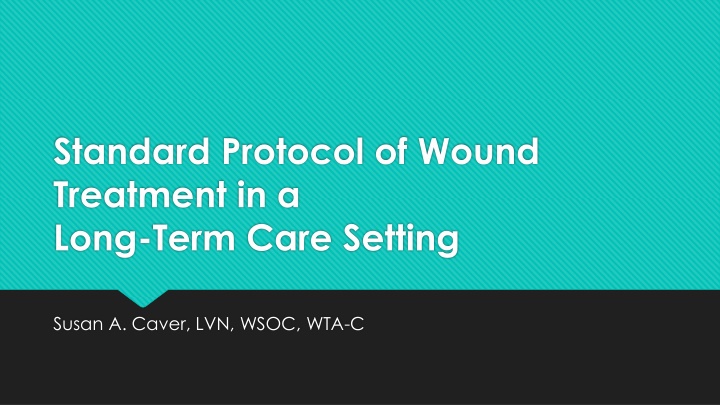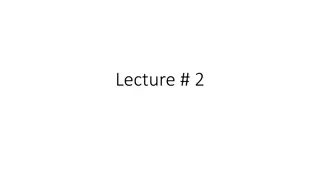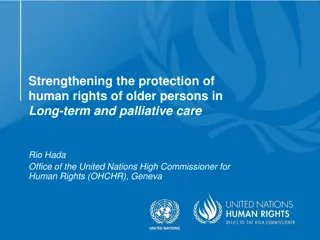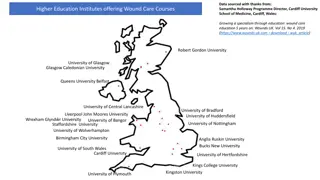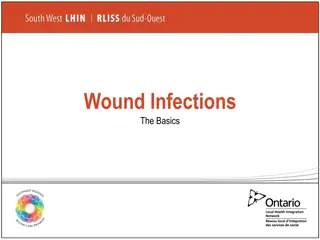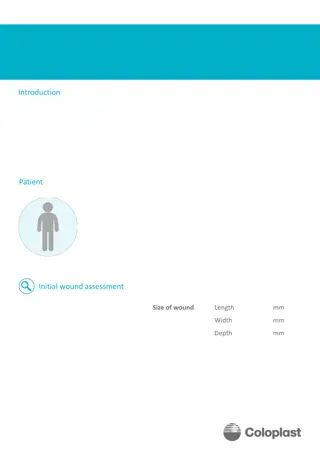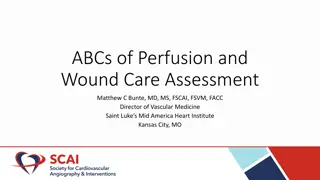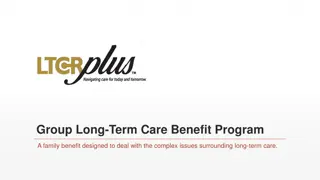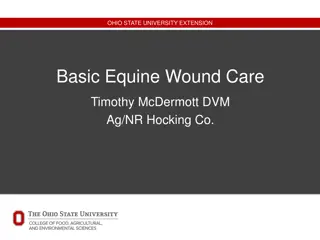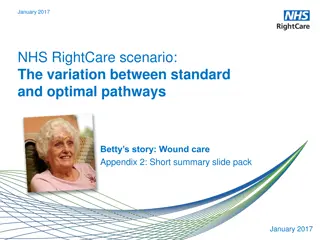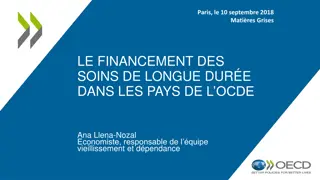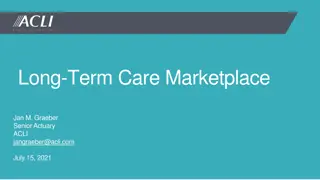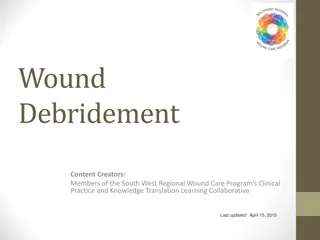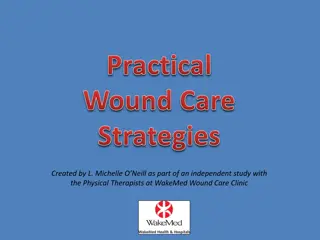Protocol of Wound Treatment in a Long-Term Care Setting
This course provides a comprehensive guide on wound care protocols in long-term care facilities. Covering assessment, prevention, interventions, and documentation, it equips administrators with the knowledge to oversee staff responsibilities effectively.
Download Presentation

Please find below an Image/Link to download the presentation.
The content on the website is provided AS IS for your information and personal use only. It may not be sold, licensed, or shared on other websites without obtaining consent from the author.If you encounter any issues during the download, it is possible that the publisher has removed the file from their server.
You are allowed to download the files provided on this website for personal or commercial use, subject to the condition that they are used lawfully. All files are the property of their respective owners.
The content on the website is provided AS IS for your information and personal use only. It may not be sold, licensed, or shared on other websites without obtaining consent from the author.
E N D
Presentation Transcript
Standard Protocol of Wound Treatment in a Long-Term Care Setting Susan A. Caver, LVN, WSOC, WTA-C
Course Objectives: At the end of the course, the Adult Residential Facilities (ARF) administrator should be able to identify these procedures and staff duties when dealing with wound injuries and skin breakdown in a long-term care setting and ensure that they are followed by the designated employees: 1. Assessment 2. Prevention 3. Interventions 4. Documentation
Assessment What should be done?
The administrator should supervise and ensure that: 1. The licensed nurse will complete a skin assessment, along with risk assessment using standardized risk assessment tool, on each resident upon admission. Thereafter, a risk assessment, will be completed weekly for the first four weeks after admission and then quarterly or when there is a significant change in condition, (as defined by MDS 3.0).
The administrator should supervise and ensure that: 2. The licensed nurse will develop a care plan to address resident risk for skin breakdown. 3. The licensed nurse will assess each resident s skin condition weekly and document findings in weekly wound report.
The administrator should supervise and ensure that: 4. The licensed nurse will assess residents for pain related to pressure injury before and after treatment. 5. The licensed nurse will use an interdisciplinary approach to facilitate care plans and progress notes will resident s status and appropriate interventions.
The administrator should supervise and ensure that: 6. The licensed nurse will attend weekly Interdisciplinary Team Meeting, and the team should educate the resident/ family on status of wound healing and prevention as well as the treatment plan.
The administrator should supervise and ensure that: 7. The licensed nurse and the Registered Dietitian will assess resident s medications, nutritional status, abnormal lab values, fluid intake, and weight changes if contributing to break in skin integrity.
The administrator should supervise and ensure that: 8. The licensed nurse will refer newly identified pressure injuries to the IDT meeting for further assessment and care planning.
The administrator should supervise and ensure that: 9. The licensed nurse will document wound related clinic visit of the resident and obtain a copy of wound clinic s documentation related to wound on each visit.
Prevention What should be done?
The administrator should supervise and ensure that: 1. The IDT, licensed nurses, and CNAs will assure the following preventive measures for resident at risk for skin breakdown: a. Apply pressure redistribution device- Low Air Loss Mattress for residents with multiple stage 2, stage 3, 4, unstageable and immobile residents.
The administrator should supervise and ensure that: b. Provide a pressure-redistribution device such as gel cushions to chair/ wheelchair and limit to 1 hour, if resident if resident has pressure injury to sacrum or buttocks.
The administrator should supervise and ensure that: c. Turn and reposition resident in bed or chair if the resident cannot do so independently. In addition, use pillows, linen rolls, heel and elbow protectors, wedges to keep bony prominences from direct contact with another or from unrelieved pressure. Elevate offload heels often or as tolerated while in bed.
The administrator should supervise and ensure that: 2. Keep linens clean smooth and free of wrinkles. 3. Keep skin moisturize to prevent dryness as appropriate. 4. Develop a plan for urinary incontinence, bowel and bladder training, toileting.
The administrator should supervise and ensure that: 5. Monitor nutrition intake and weight loss and provide intervention as applicable. 6. Maintain the head of bed at lowest degree of elevation consistent with medical conditions and other restrictions.
The administrator should supervise and ensure that: 7. Use lifting devices such as a trapeze, mechanical or electronic lifts or bed linen to move (rather than drag) the resident in bed who cannot assist during transfers and repositioning changes.
Interventions What should be done?
The administrator should supervise and ensure that: 1. The nursing staff will take preventive measures for residents at risk for skin breakdown. - The nursing staff will encourage dietary intake and increase fluids, if not contraindicated, nourishment or other supplements as recommended by the Dietitian.
The administrator should supervise and ensure that: - CNAs will complete a body checks on resident during shower or bed bath, and report findings to the charge/ treatment nurse.
The administrator should supervise and ensure that: 2. Licensed nurse will do the following if pressure injuries are identified; - Assess the wound, notify MD and obtain treatment orders as indicated, notify the family or responsible party. - Update care plans, implement care plans and interventions - Document goal, progress and effect of the interventions.
The administrator should supervise and ensure that: - Monitor nutrition intake and weight loss - Encourage/ assist consumption of food and fluids, obtain food substitutes/alternatives or fluids that are refused.
The administrator should supervise and ensure that: - Track effectiveness of treatment and notify MD for change in treatment orders, if wound is not healing in timely manner or within 2 weeks.
The administrator should supervise and ensure that: 3. For Stage 1 pressure injury, the licensed nurse notify the physician and obtain treatment order. Notify family/ responsible party of treatment plan and update care plan.
The administrator should supervise and ensure that: 4. For Stage 2 pressure injury, the IDT and licensed nurse will implement the following: - Notify the physician - Request treatment order if necessary; fortified food plan per dietitian recommendation, order of multivitamins / mineral supplements if deficiencies are suspected or identified per dietitian recommendation. - Notify family/ responsible party for treatment plan and update care plan.
The administrator should supervise and ensure that: 5. For Stage 3, 4 and Unstageable Pressure Injury, the licensed nurse will; - Notify the physician of the pressure injury and stage, request tx order as indicated. - Discuss w/ the physician the need for lab work such as pre-albumin, albumin or bmp - Consider the use of additional nutrition supplement such as zinc sulfate, vitamin C, MVI, per dietitian recommendation.
The administrator should supervise and ensure that: - Assess the need of additional positioning devices, consider the use of redistribution surface, or low air loss mattress. - If wound shows sign and symptoms of infection, notify MD or wound specialist. - Notify family/ responsible party of pressure injury and tx plan.
The administrator should supervise and ensure that: 6. Licensed nurse and social services will assess the resident for psychosocial needs to determine his/her ability to comprehend and motivation to adhere the treatment program. 7. Referral to Physical or Occupational Therapy for positioning, special devices and restorative plan.
What are the components of treatment orders, from pressure injury to other skin conditions? - Type of wound - Location of wound - Treatment to be used - Frequency of treatment - Time limit
Documentation What should be done?
The administrator should supervise and ensure that: Licensed nurse/ treatment nurse will document the status of injury site and effectiveness of the treatment for pressure injuries or other skin conditions at least every 7 days.
The administrator should supervise and ensure that: Documentation should address the following areas: 1. Site/ Location; body location, specific anatomical location 2. size- length, width and depth measurements in centimeters 3.Stage- stage 1,2,3,4, Unstageable or DTPI; no downstaging for stage 3 & 4
The administrator should supervise and ensure that: 4.Undermining/tunneling- describe present or absent, if present document in centimeters and the location involve using wound documentation clock.
The administrator should supervise and ensure that: 5. Drainage- describe the amount, type and odor as; - Amount- small, moderate or heavy - Color- serous, sanguineous, serosanguinous, purulent, or none - Odor- none or present; if present describe as foul or mild.
The administrator should supervise and ensure that: 6. Surrounding Tissues- describe condition of surrounding skin. 7. Wound base/ color- describe tissue present in the wound. 8. Wound Status- improved, or no change or deteriorated.
The administrator should supervise and ensure that: 9. Treatment/ dressing- describe the type of treatment and the dressing applied. 10. Pain assess and document interventions to related pain.
The administrator should supervise and ensure that: Document when the pressure injury is closed and continue to monitor on routine basis for indications of the risk of reopening or new skin breakdown. Implement preventive measures and skin maintenance.
Sources Dreifke, M. B., Jayasuriya, A. A., & Jayasuriya, A. C. (2015). Current wound healing procedures and potential care. Materials science & engineering. C, Materials for biological applications, 48, 651 662. https://doi.org/10.1016/j.msec.2014.12.068 Marelli, A., Calwuaerts, A., Wagner, E., D'hollander, K., & Goudmaeker, S. (2018, June). Wound Care Protocol. https://bibop.ocg.msf.org/docs/29/L029NURM02E-P_Wound-Care- protocol_OCB_EN_2018.pdf.
